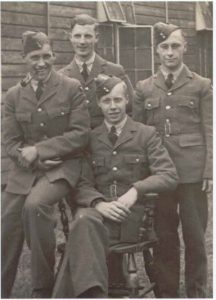On the night of 30 April on 1 May 1943, 305 aircraft, 190 Lancasters, 105 Halifaxes and 10 Mosquitos took part in a bombing flight at the industrial city of Essen in the German Ruhr area. Clouds are expected above the target and Mosquito’s equipped with Oboe radar equipment are given the task of marking the targets. The Oboe, the ‘blind bomber’, enabled them to achieve their goals with considerable accuracy. The bombardment is a success, despite the dense cloud cover this night 238 crews report that they have dropped their bomb load over Essen. 189 Buildings are destroyed, 237 seriously damaged, Krupp’s factories are bombed, and 53 are killed and 218 are wounded. Twelve Allied aircraft did not return to their base in England, 6 Halifaxes and the Lancasters ED451, ED706, ED771, ED783, ED838 and W4925. Eighty-one crew members are killed, 2 are injured and 17 are taken prisoner of war. The Halifax II with registration number JB803 was shot by Heinz Vinke at 2:26 am above Muiden and crashed into the Noordpolder. The Lancaster Mk. III ED771 is hit by Flak and crashes at 3.30 am at the Kampweg in Harderwijk.
On May 1 the Avro Lancaster Mk III took off three minutes after midnight, with serial number ED706 from RAF Station Scampton (Lincoln England) and set course to Essen.
The aircraft was deliverd on March 8th 1943 to 57 Squadron RAF and gets code DX-A.
The bomber was built between June 1942 and November 1943 by A.V. Roe and equipped with four Merlin 28 engines built in America by Packard Company with a capacity of 1,280 hp.
I
This fatefull night the ED706 has on board pilot Sgt. William John Glotham.
The 21-year-old flight engineer Sgt. John Kenneth Mansley.
The 22-year-old navigator Sgt. Albert Victor Ansell.
The 21-year-old bombardier Sgt. Michael James Grace.
The 22-year-old radio operator / air gunner Sgt. Joseph Hodgson.
The 31-year-old gunner Sgt. William Nugent
and the 18-year-old gunner Sgt. Cyril Douglas Todd, his 5th mission.
The night report shows that the aircraft is part of the 5th attack wave. The Lancaster is fired at by German defense guns (Flak) and crashed at 2.38 am in the IJsselmeer, north of Muiderberg.
In total the aircraft only made 91 flying hours.
The crew is killed in the crash, their bodies are not recovered.
All seven crew members are registered as Missing-in-Action (MIA). Their names are carved in panels 150, 158, 140, 151, 153, 160 and 167 at the Runnymede Memorial along the Thames, just outside London, where England commemorates the Royal Air Force crews who do not have a ‘known grave’.
The Lancaster was found in excavation works on plot AZ71 in 1978 and was recovered in September by the Salvage Service of the Royal Netherlands Air Force.
The aircraft must have hit the IJsselmeer in a fairly steep fall, parts of the nose dome and the tail are found in the soil at a relatively short distance from each other to a depth of 3 to 4 meters.
From the parts recovered, a bomb container and ammunition, 100 small incendiary bombs show that the aircraft crashed on the way to the target.
Research has shown that the aircraft dropped its bombs near Durgerdam before it crashed into the IJsselmeer. During the salvage work, remains of two persons are found. It is not possible for the Salvation and Identification Service of the Royal Netherlands Air Force to identify them and the remains were buried with military honor in two unnamed graves (sector 22, row F, grave 8 and 9) at the Canadian War Cemetery in Groesbeek.
Source: http://www.flevolanderfgoed.nl

As far as known, this crew was on their 3rd operation.
